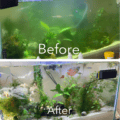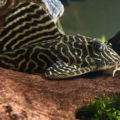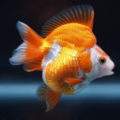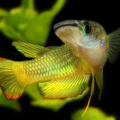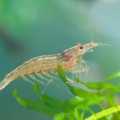Do you want to beautify your aquarium with a unique goldfish species? Then, look no further than the Panda Moor goldfish, a two-toned beauty with a striking appearance and characteristics. It’s sure to stand out amongst all the fish in your aquarium.

Beyond its beauty, however, the Panda Moor goldfish has more intriguing features. It requires minimal yet attentive care and makes an ideal tank mate to other fancy goldfish like Comet, Oranda, Ryukin, and Fantail goldfish.
Keep reading to learn how you can care for your Panda Moor goldfish.
Discover the Charm of Panda Moor Goldfish: Appearance and Characteristics
Let’s start with the Panda Moor’s appearance. It’s a unique black and white goldfish that looks like a Panda bear, hence its name, with large protruding eyes and a 6 – 8-inch body. This telescopic eyes goldfish is short, round, and chubby with long flowing fins.
As a compact goldfish, the Panda Moor has mild-mannered characteristics. Their large eyes make them sensitive to injury, and their small bodies make them prone to stress.
Ideal Habitat and Tank Requirements
Step one in healthy breeding practices is having the right Panda Moor tank setup. An ideal tank size for this fish contains at least 20 gallons of water per single fish and 10 extra gallons for every additional Panda Moor goldfish.
Other tank requirements include – proper water parameters, filtration system, and tank decor.
Water Parameters
Panda Moor goldfish water parameters are as follows:
- 65℉ – 72℉ temperature because they’re coldwater fish.
- Maintain a 6.5 – 7.5 pH level and moderate hardiness.
Aquarium Filtration
Panda Moor goldfish can survive in almost any standard aquarium filtration system. As long as the filter provides adequate filtration and aeration for the size of the aquarium. They need oxygenated water free from poisonous ammonia waste.
Tank Decor
Because of their sensitive telescopic eyes, ensure the tank decor and substrate are smooth, soft, and safe. Use sand, fine gravel, and artificial caves with soft edges.
Author’s Note: For some planted tank decor tips check out our article on The 8 Best Live Plants for Goldfish Aquariums, there are indeed live plants that can thrive in a goldfish habitat!
Diet and Feeding

Regarding feeding, the Panda Moor diet isn’t different from any other goldfish nutrition. This species needs a balanced diet of nutritious food, whether commercial pellets, flakes, vegetables, or live or frozen food.

Feeding Panda Moor goldfish isn’t time-consuming. You can adopt any regular goldfish feeding schedule where the pets eat twice daily. But don’t overfeed, ensure it’s a portion they can finish within 3 minutes.
A small portion measured for a short feeding time prevents waste, which could become harmful and lead to excess ammonia production.
For more on feeding your aquatic pets check out The Ultimate Guide to Fish Food: Pros and Cons & Best Choices!
Health and Common Diseases
Common goldfish diseases like Dropsy, Swim Bladder Disease, and Fin Rot can affect Panda Moor goldfish but are also prone to Eye problems and Ich because of their uniqueness.
Dropsy
Dropsy is a sign of an underlying disease that manifests as bloating or protruding scales. Because the Panda Moor goldfish is naturally chubby, it’s hard to spot Dropsy through its physical changes. But if you watch swimming patterns change, you can pick it out.
Treatment: Isolate the fish and medicate it with antibiotics to fight the internal bacteria. While it’s out of the aquarium, treat the water and ensure it’s at optimal parameters.
Swim Bladder Disease
Slow swimming and odd-pattern movements can also indicate swim bladder disease. When your Panda Moor goldfish has this illness, you’ll notice it sinking to the aquarium’s bottom or swimming on its side.
Treatment: Fast your fish and change its diet to fiber-rich food to reduce constipation. This will also help it shift its bowels.
Fin Rot
This is the Panda Moor goldfish’s fin rotting due to bacterial infection from poor water quality. Sometimes, it can be a mild discoloration on the fin’s edges or an obvious tattered fin.
Treatment: Get over-the-counter antibiotic medications. It could be oral or a skin cream.
Eye Problems
Having telescopic eyes makes the Panda Moor goldfish prone to injury or infections from contaminated water. I advise breeders and keepers to pair them with mild-temperament tank mates.
Treatment: Quarantine the fish to stop the infection from spreading. Then, depending on the cause of the eye problems, antifungal or antibacterial treatment can be used. Use aquarium salt to clear cloudy eyes caused by contaminated water.
Ich
When you see unusual white cottony spots and growths on your Panda Moor goldfish’s skin, that’s Ich.
Treatment: Increase the water temperature to 82℉ – 86℉ and add one to three teaspoons of aquarium salt, depending on the tank size—one teaspoon per 10 gallons. You can also visit a fish vet for more medication.
For more details on Ich, checkout our article on How to Treat Ich Outbreaks in Your Freshwater Fish!
The most proficient disease prevention practice for your Panda Moor goldfish is to feed them a balanced diet that meets their nutritional needs. Also, ensure the water parameters mimic their ideal habitat and maintain their water quality.
Breeding Panda Moor Goldfish
The most challenging part about owning this species is breeding Panda Moor Goldfish. I’ve curated a few breeding tips to guide you on this process and make it easy for first-time fishkeepers. Follow each step carefully for the best result.
Step One: Prepare your Breeding Tank
The Panda Moor goldfish breeding tank should be separate or different from the main tank. If it’s the same, create a partition for the breeding area so the spawning fish won’t mix with the non-breeders.
Get a tank that can hold at least 20 gallons of water with a standard filtration system and spawning mops for the eggs. Increase the temperature inside the tank to 68℉ – 74℉.
Step Two: Choosing the Breeding Stock
It’s best to breed 2 – 3-year-old Panda Moor goldfish. Identify the males with tiny white spots on their pectoral fins and gills. Then, pair males and females.
Step Three: Spawning

Follow these easy Panda Moor goldfish spawning tips for results.
During the breeding season, feeding your Panda Moor goldfish with rich fiber and protein foods is best. Increase their bloodworm and brine shrimp intake.
When it’s time to spawn, the male Panda Moor goldfish chases the female until she releases her eggs. Then, it fertilizes it outside her body. That’s why you need a spawning mop in your breeding tank.
Immediately after spawning, separate the adult Panda Moor goldfish from the eggs.
Step Four: Fry Treatment
It takes 4 – 7 days to hatch a Panda Moor goldfish egg, and then the fry eats the yolk sacs.
After feeding on the yolk, it’s time to switch the fry’s diet to liquid food and infusoria. Once they start growing at about one to two weeks old, you can add crushed flakes and powdered food to the diet. You see, raising goldfish fry isn’t hard!
Step Five: Conditioning for The Big Tank
Unfortunately, all goldfish fry wouldn’t grow at the same pace. So, you must monitor your pets and separate the larger fries from the small ones. If you don’t, you risk them becoming predators.
Compatibility with Other Fish
Generally, Panda Moor goldfish make peaceful tank mates. That means you can add them to a community tank without worries, but you must be cautious. The only compatible fish species with the Panda Moor are fancy goldfish.
The test for Panda Moor compatibility is based on temperament and physical characteristics.
Fancy goldfish share the same temperament and have care requirements similar to Panda Moor goldfish, so there’s no risk of predation or aggressiveness.
Care Tips and Best Practices
Knowing your Panda Moor goldfish’s sensitivity, you’ll need the best practices and care tips to ensure healthy growth. Some of these are regular goldfish care tips with additional notes peculiar to the Panda Moor species.
- Regular Tank Maintenance: This tip applies to all goldfish tank maintenance. You must clean them at least once every week to ensure it’s free from contamination.
- Maintain Good Water Quality: Keep the water parameters within the tank to ensure healthy living for your Panda Moor goldfish.
- Choose the Right Tank Mates: Create a stress-free environment by pairing your Panda Moor goldfish with compatible species.
- Less Handling: Too much touching or movement will stress your Panda Moor goldfish. When moving them, use a soft net to avoid hand-to-fish contact.
Without maintaining proper water parameters, the tank’s water quality can degrade, which can cause a wide range of issues from cloudy aquarium water to illness and mass fish die off.
Maintaining healthy goldfish isn’t hard. It only requires dedication and spending some dollars.
Common Myths and Misconceptions
Do you wonder if certain facts about Panda Moor goldfish are myths? It’s time to separate truth from fiction by debunking these popular goldfish myths and misconceptions with accurate goldfish information.
Panda Moor Myths
- They only grow as large as their tank permits.
Fact: That’s not true because the average size for a Panda Moor goldfish is 6 – 8 inches, regardless of the tank size. This growth depends on genetics and other environmental factors.
- They don’t live long.
Fact: Your Panda Moor goldfish can live for 15 – 20 years with the right care and conditions.
Panda Moor Misconceptions
- They are Low Maintenance.
Fact: Requiring minimal care doesn’t equal low maintenance because making the wrong choice can be fatal. Always be attentive to your Panda Moor goldfish.
- They need minimal space.
Fact: Don’t mistake being small for needing minimal space.
Conclusion
Okay, Panda Moor goldfish enthusiasts, that’s it for today. But first, here’s a quick recap to ensure you understood every tip on caring for this charming species.
- Don’t overfeed them.
- Keep a sizable fish tank.
- Breed your Panda Moor goldfish.
- Build a community tank with only compatible fish.
Follow this guide, and your aquarium goldfish will thrive. Welcome to the Panda Moor goldfish owners’ corner.

